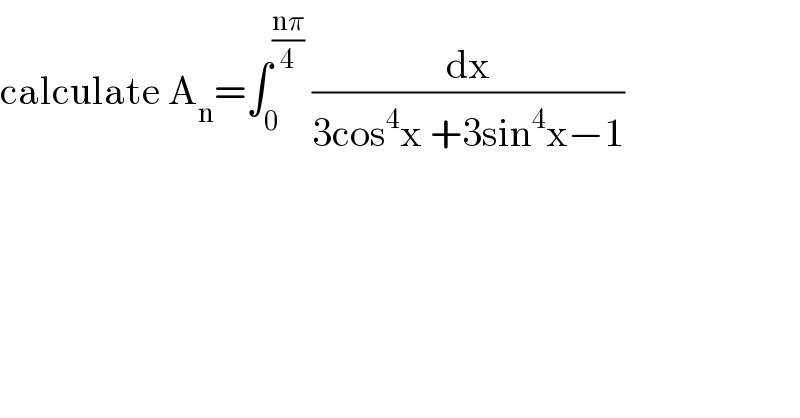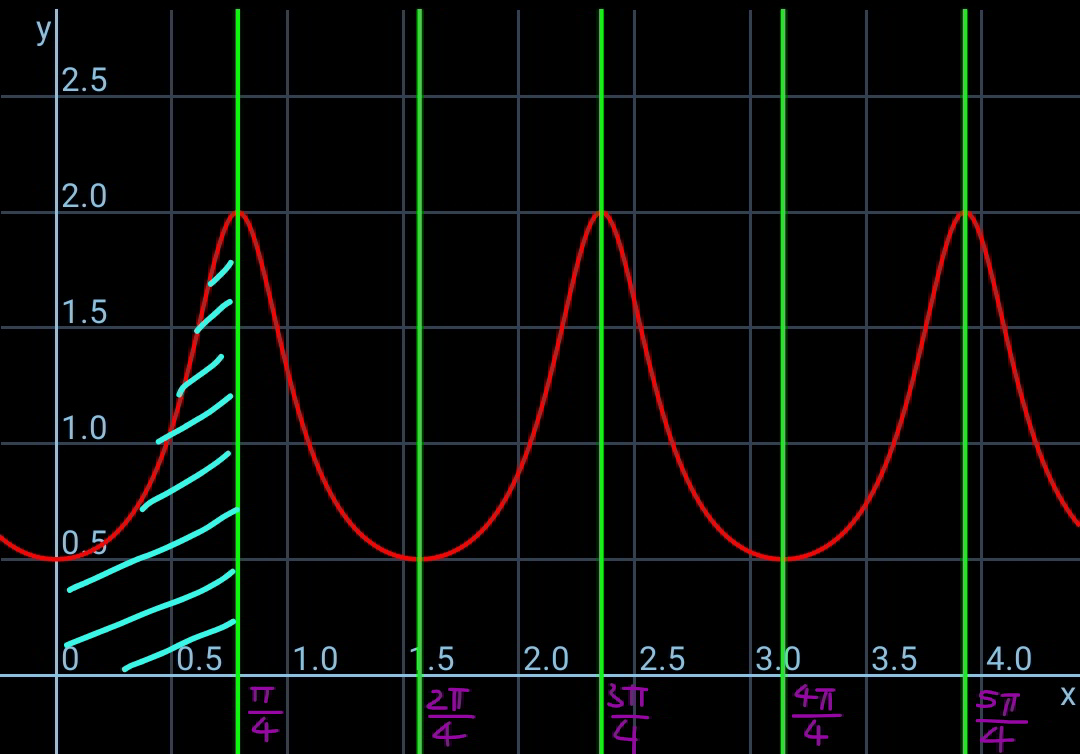
Question and Answers Forum
Question Number 97839 by mathmax by abdo last updated on 10/Jun/20

Commented by mr W last updated on 10/Jun/20
![3(cos^4 x+sin^4 x)−1 =3(cos^4 x+sin^4 x+2 cos^2 x sin^2 x)−1−(3/2) sin^2 2x =3(cos^2 x+sin^2 x)^2 −1−(3/2) sin^2 2x =(1/2)(4−3 sin^2 2x)≤2, ≥(1/2) ⇒(1/2)≤(1/(3cos^4 x+3 sin^4 x−1))≤2 ⇒∫_0 ^((nπ)/4) (dx/(3cos^4 x+3 sin^4 x−1))>(1/2)×((nπ)/4)=((nπ)/8) ⇒∫_0 ^((nπ)/4) (dx/(3cos^4 x+3 sin^4 x−1))<2×((nπ)/4)=((nπ)/2) ⇒((nπ)/8)<A_n <((nπ)/2) i.e. A_n is always >0, can never be zero! A_n =∫_0 ^((nπ)/4) ((2dx)/(4−3 sin^2 2x)) =∫_0 ^((nπ)/2) (dt/(4−3 sin^2 t)) with t=2x =n∫_0 ^(π/2) (dt/(4−3 sin^2 t)) =n[(1/2)tan^(−1) ((tan t)/2)]_0 ^(π/2) =(n/2)×(π/2) =((nπ)/4)](Q97851.png)
Answered by smridha last updated on 10/Jun/20

Answered by smridha last updated on 10/Jun/20
![∫_0 ^((n𝛑)/4) ((d(tan(2x)))/(2^2 +(tan(2x))^2 ))=(1/2)(tan^(−1) [((tan(2x))/2)])_0 ^((n𝛑)/4) =(1/2)(tan^(−1) [((tan(((n𝛑)/2)))/2)]) now for n=2m (even) A_n =0 n=2m+1(odd) A_n =(π/4)](Q97853.png)
Answered by abdomathmax last updated on 10/Jun/20
![we have 3(cos^4 x+sin^4 x)−1 =3{ (cos^2 x +sin^2 x)^2 −2cos^2 x sin^2 x}−1 =3{1−(1/2)sin^2 (2x)}−1 =2−(3/2)×((1−cos(4x))/2) =2−(3/4) +(3/4)cos(4x) =(5/4) +(3/4) cos(4x) ⇒ A_n =4∫_0 ^((nπ)/4) (dx/(5 +3cos(4x))) =_(4x=t) 4 ∫_0 ^(nπ) (dt/(4(5+3cost))) =∫_0 ^(nπ) (dt/(5+3cost)) =_(tan((t/2))=u) ∫_0 ^(tan(((nπ)/2))) ((2du)/((1+u^2 )(5+3((1−u^2 )/(1+u^2 ))))) =2∫_0 ^(tan(((nπ)/2))) (du/(5+5u^2 +3−3u^2 )) =2∫_0 ^(tan(((nπ)/2))) (du/(8+2u^2 )) =∫_0 ^(tan(((nπ)/2))) (du/(4+u^2 )) =_(u=2z) ∫_0 ^((1/2)tan(((nπ)/2))) ((2dz)/(4(1+z^2 ))) =(1/2) [arctan(z)]_0 ^((1/2)tan(((nπ)/2))) =(1/2) arctan((1/2)tan(((nπ)/2))) ⇒ A_(2n) =0 and A_(2n+1) =(1/2)×(π/2) =(π/4)](Q97921.png)
Commented by smridha last updated on 10/Jun/20

Commented by mr W last updated on 10/Jun/20

Commented by mr W last updated on 10/Jun/20

Commented by mathmax by abdo last updated on 10/Jun/20

Commented by mr W last updated on 10/Jun/20

